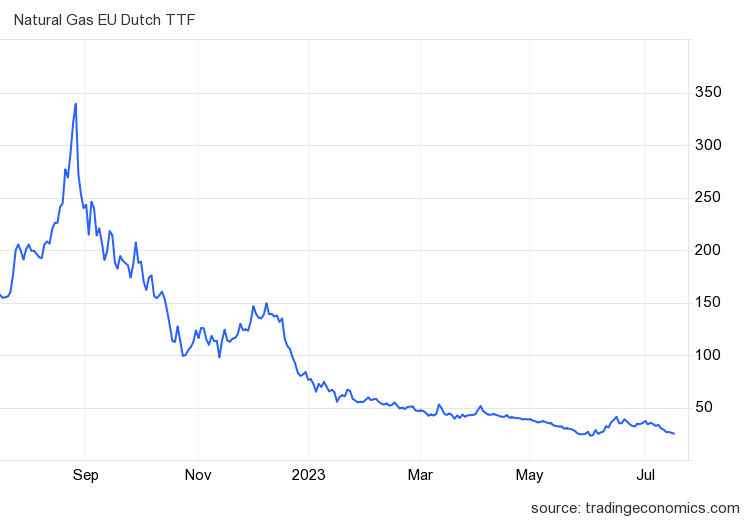On 17 July, Yle - The Finnish Public Service Media Company, reported that two liquefied natural gas (LNG) tankers leased by the Finnish state-owned company Gasum had circled in the Baltic Sea for a few weeks. In August and September last year, one of the tankers was in the Baltic Sea for three weeks, as was reported by Helsingin Sanomat.
The reasons for seemingly strange behavior are a response to the prevailing circumstances. The gas market has been very volatile since Russia attacked Ukraine in February 2022: natural gas prices hit record highs last year (and demand fell momentarily as gas users searched and explored for alternatives), and now, in turn, there seems to be too much gas available (and the price has fallen to lower levels). The effects of this summer’s momentarily weaker-than-usual demand have been felt in Europe, including the rapid build-up of gas stocks, which some experts warned about earlier in March as LNG imports surged.

Figure 1. Natural gas prices (Natural gas EU Dutch TTF, EUR/MWh). Source: tradingeconomics.com
Liquefied natural gas cannot be stored in a gas tanker for extended periods because it requires a temperature of -163°C to maintain its liquid state. At higher temperatures, LNG will vaporize, and warm weather will further accelerate the vaporization process. Natural gas must also not be released directly into the atmosphere because it is predominantly methane (CH4), a worse greenhouse gas than carbon dioxide. So far, the only option is to flare the natural gas or use it in the ship’s internal combustion engines.
LNG is high-energy-density stored energy that needs to be used in some way. Part of the LNG will gasify during sea transport, and gaseous natural gas has to be eliminated. Now the only solution to unusual situations is to use natural gas as a ship fuel, which has led to gas tankers sailing in the Baltic Sea.
Like almost any other energy source, natural gas can be converted into electricity. There is a sufficient supply in the Finnish electrical grid, reflected in low hourly electricity prices, so generating electricity from LNG for the national grid alone may not be economically viable.
However, some highly flexible industrial electricity consumers in Finland and around the world, such as computing-intensive bitcoin miners, can consume electricity produced from waste gas on a meaningful industrial scale. Miners can, anytime, anywhere, flexibly convert the waste gas into the computing resources needed to secure the bitcoin value transmission network using electricity, and energy companies could get a better return than using LNG to sail the Baltic Sea.
One can think of bitcoin mining as a security system, and the amount of computing power required to keep the globally distributed ledger is massive. Energy consumption is there to protect the network. Bitcoin needs energy, and energy companies must address their financial responsibilities and environmental commitments. Bitcoin mining using waste gas is a growing business model, with several pioneering companies and researchers working on the subject. Miners are well-versed in “identifying new and creative ways to source their power which has also resulted in the reduction of methane that enters the atmosphere,” as was recently pointed out by KPMG US Brian Consolvo and Kirk Caron overview on bitcoin mining. In a recent working paper, published by the MIT Center for Energy and Environmental Policy Research, a team of researchers stated:
Insufficient electricity demand and high investment costs often render flare gas utilization projects unfeasible. Bitcoin mining, with its location-agnostic, modular, and portable properties, offers a solution by incentivizing generator construction to convert the otherwise squandered energy into productive use and further leads to mitigating methane emissions. Critics, however, argue that this practice does not address the underlying issue of ongoing fossil fuel consumption and its environmental repercussions and may even inadvertently prolong fossil fuel dependency. (Source)
The price-responsive, location-independent, interruptible, modular, and portable nature of bitcoin mining ensures that the mining equipment - gas generators and mobile data center containers - can be quickly co-located directly to the LNG terminal to await incoming gas tankers to use the waste energy supply if required (link). Regular data centers or other high-energy consumers might be unable to take advantage of this niche opportunity as they need constant and predictable energy sources, have high opportunity costs, and possibly have high bandwidth requirements.
Conversely, bitcoin mining is a much more flexible and unpretentious energy consumer because miners are the dung beetles of the energy world, “always looking for every last drop of waster energy available because they’re incentivized to do so.” (link) Miners, so to say, sail into the wild ocean blue to discover stranded or wasted energy resources and act as dung beetles as they consume energy waste (link). They are ready to create new markets in places where no one else wants or can take advantage of all the abundant energy, and therefore mining is the ultimate buyer of last resort (link). This emerging energy-intensive industry has the ability to subsidize both the initial costs and ongoing expenses of new energy industry innovations as they are a permissionless free market energy subsidy driven by profits and market incentives, as Swan Bitcoin’s Cory Klippsten has previously argued.
Economic and environmental factors are a reasonable argument why the role of bitcoin mining in LNG supply chains may be worth further exploring. Bitcoin mining sounds unintuitive, but it’s a promising solution to stop LNG tankers from circling the Baltic Sea aimlessly and turning waste into profit and environmental benefits.
A concise version of this article, produced with Nordblock’s Jaakko Kaijala, was published in Finnish as an op-ed by the leading Finnish business newspaper Kauppalehti on 3 August 2023.
“Bitcoin mining is an apex predator, a lion. In the bear, it’s a dung beetle. … It’s the dung beetle” – Troy Cross
———
The views, opinions, and positions expressed in this article are those of the author and do not necessarily reflect the views of his employer or any other parties the author is associated with.

